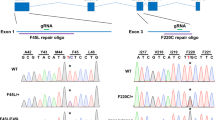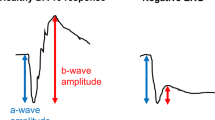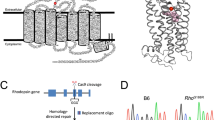Abstract
G protein-coupled receptors (GPCRs) participate in the most common signal transduction system at the plasma membrane1. The wide distribution of heterotrimeric G proteins in the internal membranes suggests that a similar signalling mechanism might also be used at intracellular locations2. We provide here structural evidence that the protein product of the ocular albinism type 1 gene (OA1), a pigment cell-specific integral membrane glycoprotein3, represents a novel member of the GPCR superfamily and demonstrate that it binds heterotrimeric G proteins. Moreover, we show that OA1 is not found at the plasma membrane, being instead targeted to specialized intracellular organelles, the melanosomes. Our data suggest that OA1 represents the first example of an exclusively intracellular GPCR and support the hypothesis that GPCR-mediated signal transduction systems also operate at the internal membranes in mammalian cells.
This is a preview of subscription content, access via your institution
Access options
Subscribe to this journal
Receive 12 print issues and online access
$209.00 per year
only $17.42 per issue
Buy this article
- Purchase on Springer Link
- Instant access to full article PDF
Prices may be subject to local taxes which are calculated during checkout






Similar content being viewed by others
References
Gudermann, T., Kalkbrenner, F. & Schultz, G. Diversity and selectivity of receptor-G protein interaction. Annu. Rev. Pharmacol. Toxicol. 36, 429– 459 (1996).
Nurnberg, B. & Ahnert-Hilger, G. Potential roles of heterotrimeric G proteins of the endomembrane system. FEBS Lett. 389 , 61–65 (1996).
Schiaffino, M.V. et al. The ocular albinism type 1 (OA1) gene product is a membrane glycoprotein localized to melanosomes. Proc. Natl Acad. Sci. USA 93, 9055–9060 ( 1996).
Horn, F. et al. GPCRDB: an information system for G protein-coupled receptors. Nucleic Acids Res. 26, 275– 279 (1998).
Altschul, S.F. et al. Gapped BLAST and PSI-BLAST: a new generation of protein database search programs. Nucleic Acids Res. 25, 3389–3402 (1997).
Pearson, W.R. & Lipman, D.J. Improved tools for biological sequence comparison. Proc. Natl Acad. Sci. USA 85, 2444–2448 (1988).
Rost, B., Casadio, R., Fariselli, P. & Sander, C. Prediction of helical transmembrane segments at 95% accuracy. Protein Sci. 4, 521–533 (1995).
Strader, C.D., Fong, T.M., Tota, M.R. & Underwood, D. Structure and function of G protein-coupled receptors. Annu. Rev. Biochem. 63, 101–132 (1994).
Hargrave, P.A. & McDowell, J.H. Rhodopsin and phototransduction: a model system for G protein-linked receptors. FASEB J. 6, 2323–2331 (1992).
Schiaffino, M.V. et al. Analysis of the OA1 gene reveals mutations in only one-third of patients with X-linked ocular albinism. Hum. Mol. Genet. 4, 2319–2325 (1995).
Schnur, R.E. et al. OA1 mutations and deletions in X-linked ocular albinism. Am. J. Hum. Genet. 62, 800– 809 (1998).
Lee, M.J., Evans, M. & Hla, T. The inducible G protein-coupled receptor edg-1 signals via the G i/mitogen-activated protein kinase pathway. J. Biol. Chem. 271, 11272–11279 ( 1996).
Bourne, H.R. How receptors talk to trimeric G proteins. Curr. Opin. Cell Biol. 9, 134–142 ( 1997).
Cole, S.R., Ashman, L.K. & Ey, P.L. Biotinylation: an alternative to radioiodination for the identification of cell surface antigens in immunoprecipitates. Mol. Immunol. 24, 699–705 (1987).
Winder, A.J., Wittbjer, A., Rosengren, E. & Rorsman, H. The mouse brown (b) locus protein has dopachrome tautomerase activity and is located in lysosomes in transfected fibroblasts. J. Cell. Sci. 106, 153–166 ( 1993).
Odorizzi, G., Cowles, C.R. & Emr, S.D. The AP-3 complex: a coat of many colours. Trends Cell Biol. 8, 282–288 (1998).
Slot, J.W. & Geuze, H.J. Gold markers for single and double immunolabeling of ultrathin cryosections. in Immunolabeling for Electron Microscopy (eds Polak, J.M. & Varndell, I.M.) 129 –142 (Elsevier, Amsterdam, 1984).
Brown, W.J. & Farquhar, M.G. Immunoperoxidase methods for the localization of antigens in cultured cells and tissue sections by electron microscopy. Methods Cell. Biol. 31, 553– 569 (1989).
Mironov, A.A. Jr, Polishchuk, R.S., Luini, A. & Mironov, A.A. The role of fixative composition in preservation of both ultrastructure and antigenicity of Golgi complex in RBL and NRK cells. J. Comput. Assist. Microsc. 8, 231– 232 (1996).
O'Donnell, F.E. Jr, Hambrick, G.W. Jr, Green, W.R., Iliff, W.J. & Stone, D.L. X-linked ocular albinism: an oculocutaneous macromelanosomal disorder. Arch. Ophthal. 94, 1883–1892 ( 1976).
Frangioni, J.V. & Neel, B.G. Solubilization and purification of enzymatically active glutathione S-transferease (pGEX) fusion proteins. Anal. Biochem. 210, 179 –187 (1993).
Acknowledgements
We thank M. Fabbri and R. Halaban for anti-β1 integrin subunit and anti-tyrosinase antibodies, respectively; P. De Camilli, S. Colamarino, I. De Curtis, V. Marigo, R. Pardi, E. Rugarli, S. Schiaffino, R. Sitia and L. Vallar for helpful suggestions; T.E. Kreis for the use of epifluorescence microscopy and camera equipment; and A.A. Mironov for the immunoperoxidase staining method. The support of the Vision of Children (San Diego) and the Italian Telethon Foundation (grants E.583, A.41 and A.106) is gratefully acknowledged. This work was also supported by Ministero della Ricerca Scientifica (MURST) and by Consiglio Nazionale delle Ricerche (CNR finalizzato "Biotecnologie"), Italy, and by EEC Biomed 2 grant no. BMHG4-97-2062.
Author information
Authors and Affiliations
Corresponding author
Rights and permissions
About this article
Cite this article
Schiaffino, M., d'Addio, M., Alloni, A. et al. Ocular albinism: evidence for a defect in an intracellular signal transduction system. Nat Genet 23, 108–112 (1999). https://doi.org/10.1038/12715
Received:
Accepted:
Issue Date:
DOI: https://doi.org/10.1038/12715
This article is cited by
-
Lysosomes as dynamic regulators of cell and organismal homeostasis
Nature Reviews Molecular Cell Biology (2020)
-
Identification of a novel GPR143 mutation in X-linked ocular albinism with marked intrafamilial phenotypic variability
Journal of Genetics (2018)
-
GPR143 Gene Mutations in Five Chinese Families with X-linked Congenital Nystagmus
Scientific Reports (2015)
-
Structural insights into human GPCR protein OA1: a computational perspective
Journal of Molecular Modeling (2012)
-
Bad signals jam organelle traffic
Nature Medicine (2007)



